Immerse yourself in the mystery of the Acacia Grove in the Bible, a symbol of resilience and sacredness with untold stories waiting to be discovered.
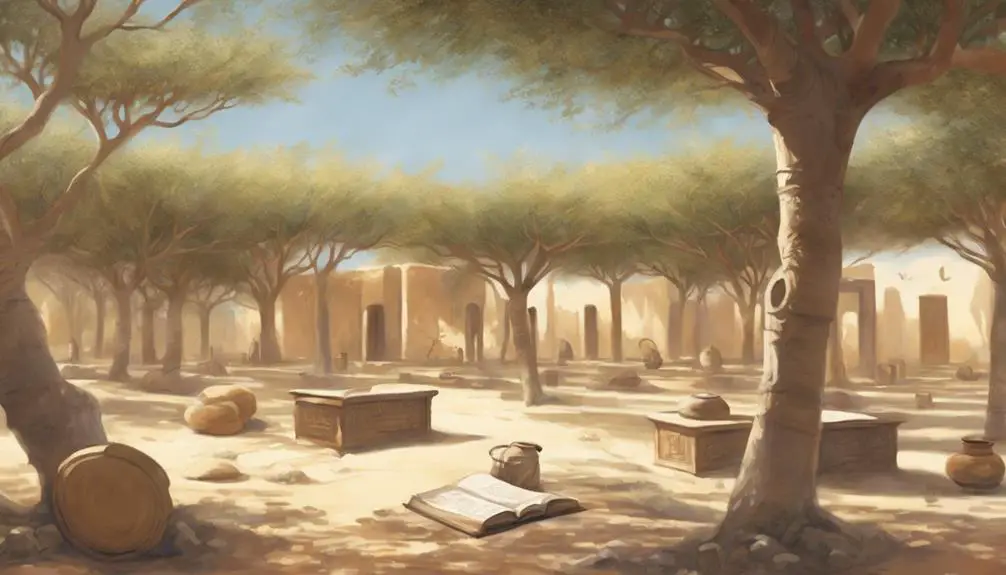
Acacia Grove in the Bible
Navigating through the biblical landscape, you'll encounter the acacia grove, a symbol as enduring as the ancient texts themselves. You're about to explore its historical significance, its profound symbolism, and why it was chosen for sacred constructions.
Beyond its biblical presence, the acacia grove holds a fascinating ecological and cultural impact that has resonated through the ages. As you trace its roots from biblical references to modern interpretations, you'll uncover stories that have shaped faiths and cultures.
Prepare to embark on a journey that bridges the past with the present, where the acacia isn't just a tree but a living testament to resilience and spirituality.
Key Takeaways
- Acacia groves were central to biblical narratives, symbolizing spiritual resilience and purity.
- Acacia wood's durability made it the chosen material for sacred constructions like the Ark of the Covenant.
- Located along vital trade routes, acacia groves facilitated ancient trade networks and cultural exchanges.
- The ecological role of acacia in preventing desertification highlights its importance in biblical lands' environmental sustainability.
Historical Significance
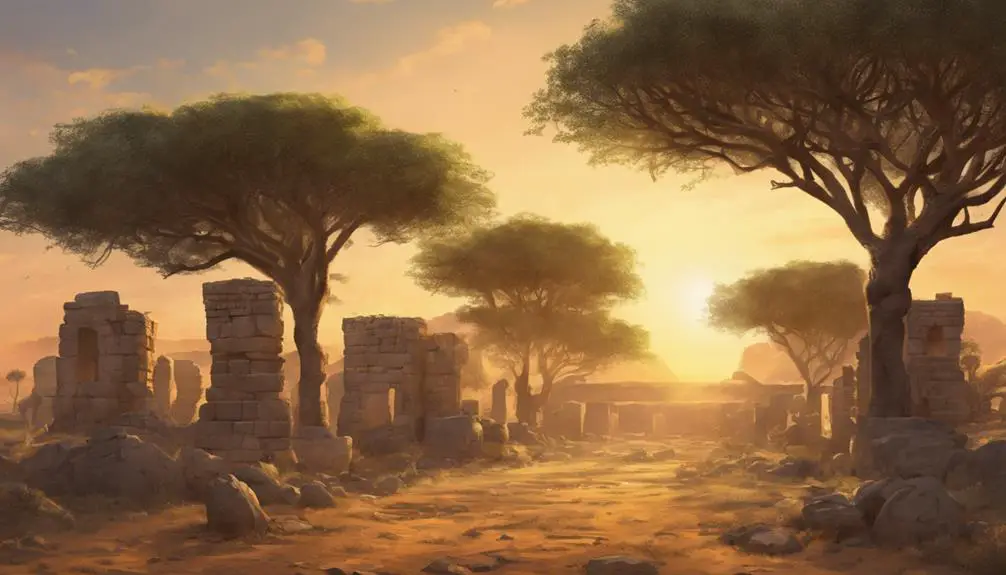
Acacia groves hold a pivotal place in biblical narratives, serving as silent witnesses to key historical and spiritual events that shaped the faiths of millions. You'll find that their significance isn't just spiritual or symbolic but deeply rooted in the socio-economic fabric of ancient Near Eastern societies. The geographic distribution of acacia trees, predominantly in the Sinai Peninsula and the regions surrounding the Dead Sea, placed them along crucial trade routes. This positioning was instrumental in the development and sustenance of trade networks.
You must understand that these groves weren't merely accidental features of the landscape. Their presence along trade routes meant that they were vital waypoints for caravans. The acacia wood, known for its durability and resistance to decay, became a sought-after resource, not just for construction but for trade as well. Its value was enhanced by the scarcity of other timber resources in these arid regions.
Thus, the historical significance of acacia groves extends beyond their biblical mentions. They're emblematic of the intertwining of natural resources with human civilization, playing a critical role in the development of trade and the economic landscape of the ancient Near East.
Symbolism and Meaning
Beyond their historical and economic roles, the acacia groves embody a rich tapestry of symbolism and meaning in biblical contexts, reflecting deep spiritual truths and theological principles. This resilient wood, often flourishing in arid conditions, stands as a potent symbol of spiritual resilience and endurance. Its presence in scripture isn't merely incidental; rather, it's woven into narratives to evoke divine imagery and underscore a relationship with the divine that's both nurturing and enduring.
You'll find that acacia's symbolism extends beyond its physical characteristics to represent purity, incorruptibility, and the connection between the earthly and the divine. Its hardy nature, capable of thriving in harsh environments, mirrors the spiritual journey of believers who are called to persevere in their faith amidst trials and tribulations. Moreover, the acacia's durability and resistance to decay make it a fitting emblem for eternal life and the unyielding strength of the human spirit when aligned with divine purposes.
Acacia in Sacred Constructions
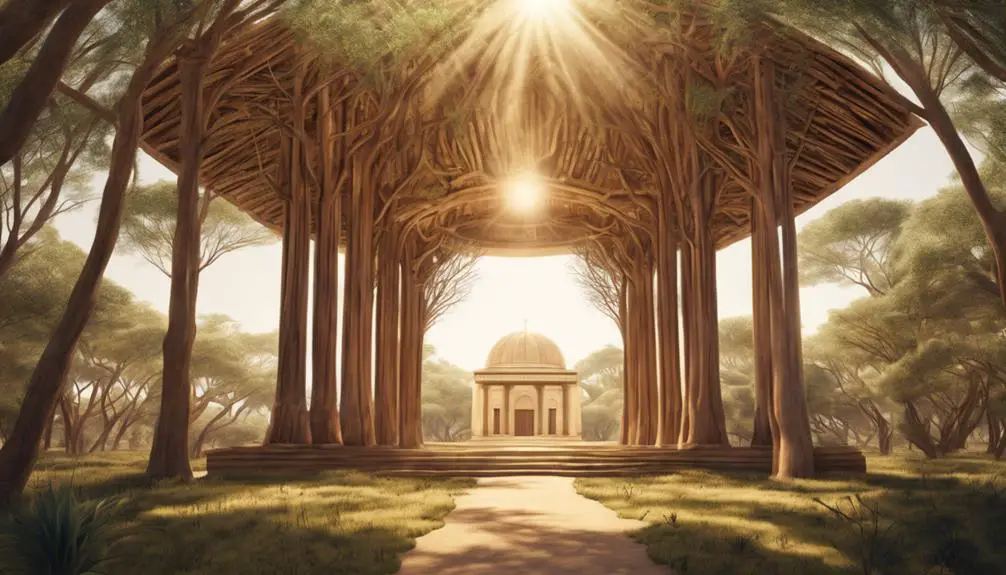
Reflecting on the symbolic significance of the acacia, it's essential to explore its pivotal role in the construction of sacred edifices within the biblical narrative. The acacia's resilience, attributed to its desert adaptation, made it a prime candidate for crafting materials destined for holy purposes. This tree, thriving in arid conditions, symbolized endurance and purity, qualities esteemed in sacred construction.
Delving deeper, you'll find that the acacia's wood wasn't only durable but also resistant to decay and insects, attributes crucial for the longevity of sacred structures. The Israelites, leveraging their crafting techniques, transformed this robust wood into the Ark of the Covenant, the Tabernacle, and the altar—key components in their worship practices. These constructions weren't mere architectural feats; they were imbued with profound spiritual significance, serving as tangible manifestations of the divine presence amongst the people.
Moreover, the meticulous crafting techniques employed by the Israelites to work with acacia wood underscored a deep reverence for the materials provided by the divine. Each piece was carefully selected, shaped, and assembled, ensuring that the sacredness of the construction process mirrored the holiness of the edifices they were building. This fusion of divine provision, human skill, and natural resilience highlights the acacia's integral role in connecting the spiritual and the material within the biblical landscape.
Ecological and Cultural Impact
While exploring the acacia's role in sacred constructions, it's crucial to examine its broader ecological and cultural impact on ancient societies. The acacia didn't just serve as a material resource; it played a significant role in shaping the environmental landscape and cultural ethos of regions where it flourished. Its resilience and adaptability to harsh climates made it a key player in ancient efforts at climate adaptation, offering lessons for modern conservation efforts.
You'll find that the acacia was more than a tree; it was a lifeline in arid areas, providing shade and stabilizing the soil, thus preventing desertification. Its ability to thrive in challenging conditions made it a symbol of life and endurance, deeply entwined with the cultural fabric of communities that depended on it. These communities developed practices centered around the sustainable management of acacia groves, which can be seen as early forms of environmental stewardship.
Today, as we face global climate challenges, the acacia's story offers valuable insights. It's a testament to the importance of integrating traditional knowledge with modern conservation strategies to enhance ecosystem resilience. The acacia's legacy, therefore, stretches beyond its biblical significance, highlighting a timeless bond between nature and human culture, and underscoring the critical need for climate adaptation strategies that are both ancient and urgently contemporary.
Biblical References and Stories

Diving into the biblical narrative, you'll find the acacia tree weaves a rich tapestry throughout ancient texts, serving not only as a critical resource but also symbolizing enduring spiritual and physical resilience. Its geographical distribution across the arid and semi-arid regions of the Middle East played a pivotal role in the lives of the people depicted in the Bible, influencing various cultural practices and stories.
The acacia's presence in scripture isn't incidental. Consider the construction of the Tabernacle, where acacia wood was chosen for its incorruptibility and strength, symbolizing the unyielding faith of the community in their covenant with God. This choice reflects a deep understanding of the material's properties, intertwined with spiritual significance, showcasing the harmonious blend of practicality and faith.
Moreover, the acacia groves provided not just material but also spiritual sustenance to the people. They were places of refuge and worship, illustrating how geographical elements can shape cultural practices and religious expressions. These stories emphasize the acacia's role in shaping the socio-religious landscape, illustrating a profound connection between the people, their environment, and their faith.
Frequently Asked Questions
How Do Contemporary Religious Practices Incorporate Acacia Symbolism or Elements From Acacia Groves?
In contemporary religious practices, acacia symbolism is woven deeply into ceremonies and symbolic carpentry. You'll find acacia elements serve as metaphors for immortality and purity, reflecting its enduring nature.
Through acacia ceremonies, communities connect with ancient traditions, embedding these symbols in rituals and sacred objects. Symbolic carpentry, utilizing acacia wood, crafts items imbued with spiritual significance, bridging the divine with the material, and offering a tangible connection to the transcendent.
Are There Any Specific Health Benefits or Traditional Medicinal Uses Associated With Acacia Species Mentioned in the Bible?
You're exploring the health benefits of acacia species, notably Acacia honey and Gum arabic.
Acacia honey, praised for its antioxidant properties, may support immune health and wound healing.
Gum arabic, derived from acacia sap, serves as a prebiotic, promoting digestive health by fostering beneficial gut bacteria.
These uses, deeply rooted in tradition, reflect a rich history of medicinal practices, showcasing acacia's enduring relevance in natural remedies and health supplements.
How Has the Portrayal of Acacia Groves in Biblical Texts Influenced Modern Literature, Art, or Music?
As the saying goes, 'A picture is worth a thousand words,' and acacia metaphors in modern literature, art, and music often paint vivid pictures of resilience and renewal. These portrayals draw deeply on ecological symbolism, tracing roots back to ancient narratives.
Can Acacia Groves or Trees Be Found in Regions Outside of the Historical and Geographical Contexts Mentioned in the Bible, and How Do These Locations Treat or Regard Acacia?
Yes, acacia trees can indeed be found beyond their biblical settings. Global acacia distribution has spread them across various continents, adapting to different climates and soils.
Acacia cultivation techniques have evolved, allowing these trees to thrive in new environments. These locations often hold acacia in high regard, valuing them for their resilience and the benefits they provide, such as shade and resources for local wildlife, reflecting a deep respect for their ecological contributions.
Are There Any Notable Archaeological Discoveries or Findings Related to Acacia Groves That Have Shed New Light on Biblical Narratives or Periods?
Imagine stumbling upon secrets hidden in wood and groves.
While no specific archaeological findings solely link acacia groves to new insights on biblical narratives, acacia woodwork and its symbolism have been pivotal in understanding ancient cultures.
This wood's durability and the groves' sacred connotations offer a glimpse into past rituals and beliefs.
Delving into these elements can enrich our grasp of historical contexts, albeit indirectly spotlighting biblical periods and stories.
Conclusion
In sum, you've ventured through the acacia grove, not just as clusters of trees in the arid landscapes of biblical narratives but as pillars of symbolism and sacred architecture.
Ironically, for a plant so associated with endurance and permanence, its most profound impact might just be how it underscores the transient nature of human endeavors.
Through the lens of history, symbolism, and ecology, the acacia's tale is a reminder that sometimes, the most enduring lessons come from the most unexpected sources.

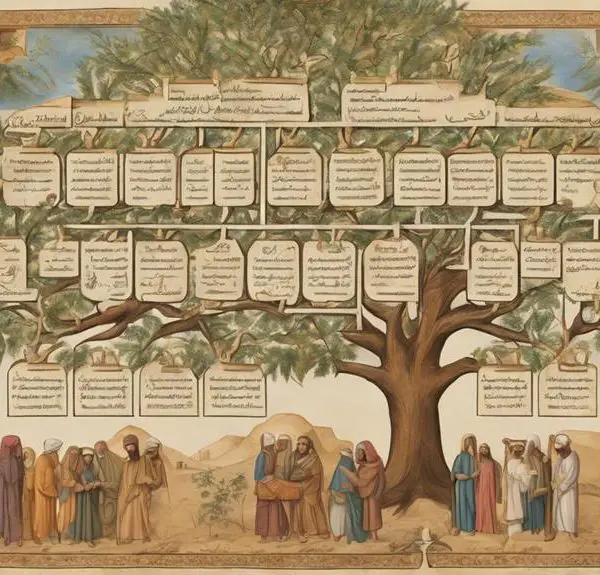
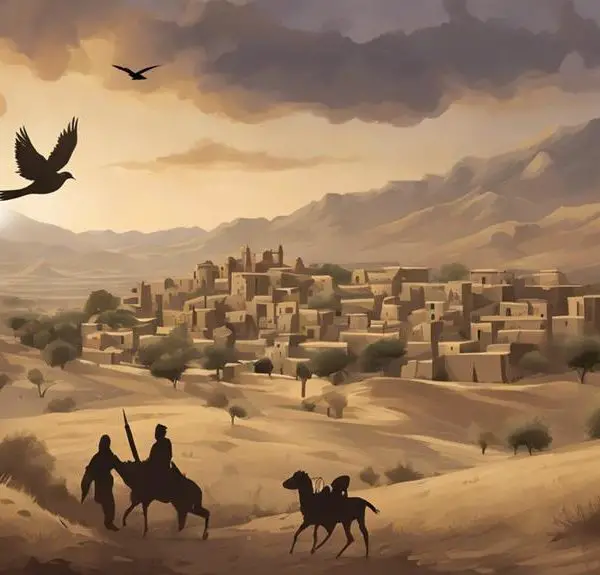
Sign up